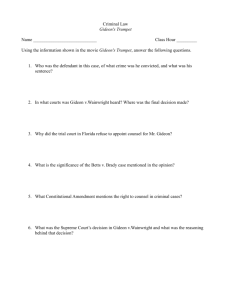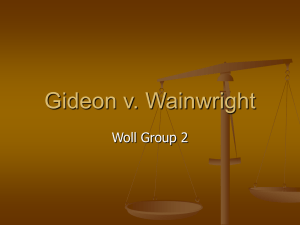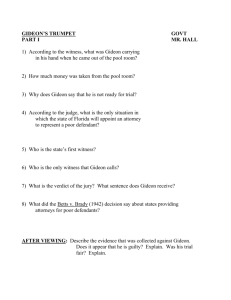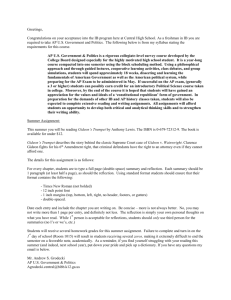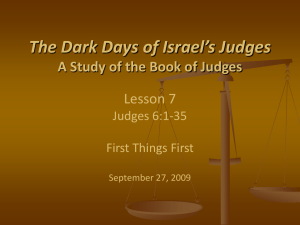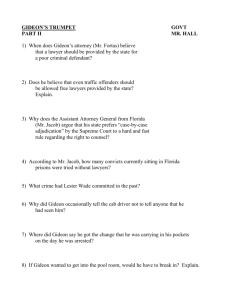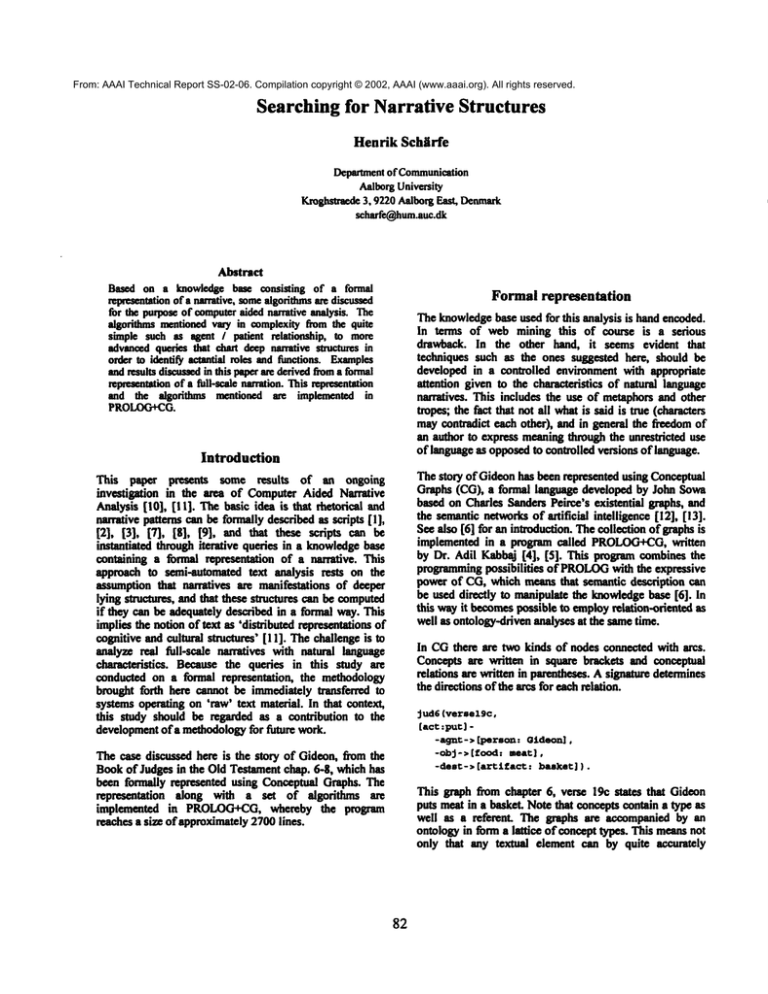
From: AAAI Technical Report SS-02-06. Compilation copyright © 2002, AAAI (www.aaai.org). All rights reserved.
Searching for Narrative Structures
Henrik Schirfe
Department of Communication
Aalborg University
Kroghstreede 3, 9220Aaltmrg East, Denmark
scharfe(~hum.anc.dk
Abstract
Based on a knowledge base consisting of a formal
relxesentation of a narrative, somealgoritinns are discussed
for the purpose of computeraided narrative analysis. The
algorithms mentioned vmyin complexity from the quite
simple such as agent / patient relationship, to more
advancedqueries that chart deep narrative structures in
order to identi~y Letantial roles and functions. Examples
andresults discussedin this paper are derived froma formal
representation of a full-seaie narration. This representation
and the algorithms mentioned are implemented in
PRONG.
Formal representation
The knowledgebase used for this analysis is hand encoded.
In terms of web mining this of course is a serious
drawback. In the other hand, it seems evident that
techniques such as the ones suggested here, should be
developed in a controlled environment with appropriate
attention given to the characteristics of natural language
narratives. This includes the use of metaphors and other
tropes; the fact that not all what is said is true (characters
may contradict each other), and in general the freedom of
an author to express meaning through the unrestricted use
of langnngc as opposed to controlled versions of language.
Introduction
This paper ixesents some results
of an ongoing
investigation
in the area of Computer Aided Narrative
Analysis [10], [I l]. The basic idea is that rhetorical and
narrative patterns can be formally described as scripts [I],
[2], [3], [7], [8], [9]° and that these scripts can be
instantiated through iterative queries in a knowledgebase
containing a formal representation of a narrative. This
approach to semi-antomated text analysis rests on the
assumption that narratives are manifestations of deeper
lying structures, and that these structures can be computed
if they can be adequately described in a formal way. This
implies the notion of text as ’distributed representations of
cognitive and cultural structures" [ 11]. The challenge is to
analyze real full-scale narratives with natural language
characteristics.
Because the queries in this study are
conducted on a formal representation,
the methodology
brought forth here cannot be immediately transferred to
systems operating on ’raw’ text material. In that context,
this study should be regarded as a contribution to the
development of a methodology for future work.
The case discussed here is the story of Gideon, from the
Book of Judges in the Old Testamem chap. 6-8, which has
been formally represented using Conceptual Graphs. The
representation
along with a set of algorithms are
implemented
in PROLOG+CG,whereby the program
reaches a size ofapproxinmtely 2700 lines.
The story of Gideon has been represented using Conceptual
Graphs (CG), a formal language developed by John Sowa
based on Charles Sanders Peirce’s existential graphs, and
the semantic networks of artificial intelligence [12], [13].
See also [6] for an introduction. The collection of graphs is
implemented in a pmgrmn called PROLOG+CG,
written
by Dr. Adil Kabhaj [4], [5]. This program combines the
programming possibilities
of PROLOG
with the expressive
power of CG, which means that semantic description can
be used directly to manipulate the knowledge base [6]. In
this way it becomes possible to employ relation-oriented as
well as ontology-driven analyses at the same time.
In CGthere are two kinds of nodes connected with arcs.
Concepts are written in square brackets and conceptual
relations are written in parentheses. A signature determines
the directions of the arcs for each relation.
jud6
(verse19c,
[act :put] -ague-> [person: O:tdeon],
-obJ-> [good: meat],
-deoC->
[artifact:
basket]
).
This graph from chapter 6, verse 19c states that Gideon
puts meat in a basket. Note that concepts contain a type as
well as a referent.
The graphs are accompanied by an
ontology in form a lattice ofeoncept types. This meansnot
only that any textual element can by quite accurately
82
accounted for, but also that specific information can be
added to the knowledgebase independent of the actual
representation. For example: it is commonly
agreed that
conflicts are of prime interest in narratives, but bowcan
conflicts be identified? In the ’Gideon ontology" the
concepttype ’act’ is divided into several types including
one called ’conflict_act’. This category contains words
such as ’encamp’, ’destroy’, and ’slay’. Because of the
subtype relation in the ontology, this information in not
required in the actual representation: [act: slay] is just as
computable as [conflict_act: slay]. But having the
informationpresent in the ontology enables the analyst to
search for wordsthat belong to that particular category.
This methodologyhas also been used to implementspeech
act theory in the knowledgebase, but naturally there are
somelimitations to this approach;there mayexist conflicts
that are not madeexplicit throughthe use verbs indicating
aggression.
Searchingfor structure
The algorithms range in complexity from very simple
structures such as family relations to rather complicated
matterssuchas deepactantial structures.
Analyzing talk
Followingis a simple exampleof an algorithm that reveals
twopieces of relation-oriented content in one query.
Islnstance(a0conflict_act).
’subsume’searches for graphs in the knowledgebasethat
are less general than the graphspecified in the query. Note,
that the first argumentof subsumeis a ConceptualGraph,
containing conceptual relations as well concepts, in this
particular case, the algorithm is constructed for maximum
flexibility by allowing any concepts below’universal’ in
the roles of agent and patient. In this way,persons,animals,
or societies can be listed in one single query. All
occurrencesof graphs containing a ’conflict act’ linked to
an agent and a patient are nowlisted underthe name’g’.
The second operation, ’branchOfCG’investigates the
graphs identified abovefor morespecific information.This
is done three times, one time for each variable.
BranchOfCG
splits the entire collection of graphs ’g’ into
parts, listing all occurrent relations between any two
conceptsin these graphs, in order to find agent and patient,
the concept in question is equipped with type as well as
referent. The types are not reported as a result, but the
referents are nowdefined as agent and patient respectively
of someconflict_act. The act itself is than replaced by a
variable so that it can be reportedby the query. Becausethe
graphs ’g’ may contain references to other actions
(concepts that haveagents), the operation "islnstancc’
applied to the graphs, lslnstance is a type goal, which
checksthat the variable is in fact an instance of the type
’conflict act’.
talks(c,v,e, r) : -Judge(c,
(universal
: s] <-agnt-[uttr]-rcpt-¯[universal
: r] ).
Whenexecuted, this algorithm returns chapter (c), verse
(v), agent (sl), action (a), and patient (s2) of all conflicts
reported in the text. Examples
include:
Because the type of agent and patient are lett open
(universal is the top of the ontology), the results include
individuals as well as societies. Among
the results are:
{C = 6, V = verse3, sl = Midian, a = attack, s2 =
Israel}
{c = 7, v = verse25c, sl = Ephraim, a - kill, s2
= zee~}
{c = 80 v = verse21b, sl = Gideon, a = slay, s2 =
{Zebah0 ZalBunna}}
{c = 6, v - verse22b0 s = Gideon, r - himself}
{c = 6, v = verse26b° s = LORD, r - Gideon}
{c - 6° v = verse30, s - Ophrah, r = Joash},
Theseresults canbeparaphrased
as: "MidianattacksIsrael
in chapter6, verse Y, ’Ephraimkills Zeebin chapter7,
verse 25c’, and "Gideonslays Zehahand Zalmuunain
chapter8, verse21b’.
stating that Gideonis talking to himselfin 6:22b, that the
LORD
is talking to Gideonin 6:26b, and that the menof
Ophrahare talking to Joash in 6:30. It follows that the
algorithmcan be altered to search for a specific agent or
patient of an utterance.
Deep Structures
in the worksof narratologists such as Proppand Greimas,
deepstructures are of great importance[i], [2], [3]. The
notion of deep structures implies that structures are
distributed into different parts of the narration. This again
calls for a methodof analysis that can handle narrative
succession and tzansformation by combining semantic
informationretrieved fromdifferent parts of the narration. I
submitthat at least someof these structures can be formally
described as scripts, thereby becoming available for
computeraided analysis. A good exampleof this is the
perhaps most common
instantiation of the semiotic square:
the two-foldtransportation ofvaluesof object [3].
Conflicts
A slightly moreelaborated exampleinvolves conflicts. In
this algorithm:
conflict
(c,v, el,a, s2): Judge (c,v,g},
subsume( [universal]<-pint-[conflict_act]
-agnt¯ [universal]
,g),
branchOfco([conflict__act]
-agnt->[r: el] ,g},
branchOfCG([conflict_act]-ptnt->[s
: s2] ,g),
branchOfco([a] -agnt-¯[r: el] ,g),
83
Greimas argues that a commonsemiotic display of a
narration can be articulated as a conflict between two
societies, and that two movements
manifest the conflict and
its solution. Thefirst movement
is performedby the villain,
whoremovessomething(or someone)from the homeof the
hem; the second movementconsists of the hero bringing
the item in question (or something similar) back. This
structure is commonly
displayedas in figure !.
Homeof the hero
Home
of the villain
Hero
Villain
detailed theoretical foundations for the double transfer
script are accountedfor in [10].
1 find it appropriateto suggest, that this structure is far
more commonthat the fairy tales from which it was
original derived. However,the script maybe found in
different variants, dependingon the actual use. Wemight
say, that the original script as suggested in [10] is a
prototypical exampleof a numberof scripts that share the
samebasic structure and purpose, but that someelements
can he replaced by other elements. The basic structure is
constituted by two successively analogous actions
characterizedby the switchingof agent and patient, both of
whichare representedby a society and by an individual.
Theobjects of the script, on the other hand, mayappear as
physical, abstract, or symbolic manifestations of something important enoughto be of significance to the entire
narration. If vengeanceor justice is a prevalent themeof a
narrative, the object of the secondaction is not necessarily
physical, but the basic structure remains the same. From
this it followsthat certain modificationscan be madeto the
script withoutdeprivingit of its fundamental
qualities.
Figure-I ATypicalnarrative scheme
The importanceof this structure lies in the fact that this
relatively simple arrangement holds an enormousamount
of informationembedded
in it. 1 will refer to this structure
as a ’double transfer’. Thedouble_transferfigure contains
information~d~outa fundamentalplot structure, and reveals
four out of six actants in the actantial modelformulatedby
Greimas[2].
Searching for a hero
Based on the double_transfer script an algorithm can be
designedthat starts by locating two societies in conflict.
Secondly, individuals from the two societies must be
identified. This is done by a separate algorithm that
searches for appropriate relations between persons and
societies. Thirdly, a temporal order must be established
betweenthe two parts of the script. Applyinga predicate
depending on the graph numberdoes this. Fromthis it
follows that an exampleof a double_transferalgorithm can
looklike this:
The double_.transfer script
Whatreally strikes meabout the double_transferpattern is
its simplicity. The graphical display of Figure I can be
formallydescribed as a script by the followingCG:
[NarratlveScrlpt:
[Proposition:
[transfer: #l]-(agnt)->[Actant:
-(ptnt)->[Society:
double_transfer(A2,S2,b,O1,A1,Sl0d):Judge(c,v°g),
double_transfer:
subsume([con£11ct_act:a]-agnt->[soclety],g),
branchOfCG(
[confllct act:a]-agnt->[soclety
"2],
branchOfCG(
[confllct_act:a]-ptnt->[soclety
*I],
-(obJ)->[Value object: *i],
-(benf)->[Society:
*2]]-
: S2],g)
:
Sl],g),
home_of(A1,S1)°
ho~e of(A2,S2),
judge(cl,vl,gl),
-(succ)->
[Proposition:
subsume|[confllct_act:b]-agnt->[socSety],gl)
[transfer: #2]-(agnt)->[Actant: "1],
-(ptnt)->[Society: -2],
branchOfCG(
[conflict
branchOfCG(
-(obJ)->[Value object: "2],
-(benf)->[Society: *i]]].
act:b]-agnt-p[society
: S2],gl),
[confllct act:b]-Rl->[s:O1],gl),
member(Rl,(ptnt,tham)),
after(c2,v2,cl,vl)°
Judge(c2,v2,g2},
Thescript is a closed structure in the sense, that if any of
the elementsare presentin precisely this capacity,all of the
others must by necessity be present in the text as well.
Furthermore,if this structure is foundin a text, the slot
named’Actant:*2’ will alwayssignify the villain, and the
slot named’Actant:*l’ will always signify the hem. The
subsume ((conflict_act:d]-agnt->
[person]
,g2),
branchOfCG([conflict_act:d]-agnt->[p:Al]0g2),
branchOfCG([confllctact:d|-ptnt->[p:A2],g2).
84
The algorithm searches the knowledge base for three
different sets of conflict-actions in different graphs,
incorporates two different algorithms that checks the
temporal order, and the societies to whichthe candidates
belong. Whentested on the Gideonstow, the results are:
Searching for functions
In the work of Propp [7], the narration is seen as a
sequence of functions performed by the key characters.
Examplesof such functions are "villainy’, ’struggle’, and
’the hem’swedding’.Someof the very important functions
are the ’interdiction’ andthe ’violation of the interdiction’.
Thesefunctions arc of particular interest becausethe theme
of the narrative quite often is reflected in the nature of the
interdiction. For computeraided analysis the identification
of such a ’Law’is complicatedby the fact that the Lawmay
or maynot be referred to directly, in manynarratives the
Lawis simple presupposed, or referred to by somenoncentral character.
To comprise the most common
realizations of this narrative element a number of
algorithmsare needed.In the followingI shall present one
exampleof such an algorithm.
{A2 = Zebah,52 = Midian, b = attack, Ol = Israel, AI = Gideon.SI =
Israel, d = pursucl
{A2 = Zebah,52 = MidiLu, b = amlck, Ol = Israel, AI = Gideon,SI =
israel,d : slay)
{A2= Zebah, S2 : Midian, b = encamp,Ol : Israel, AI = Gideon, Sl =
hrael, d = purme}
{A2= Zebah, $2 = Midian, b = encamp,Ol = Luaei, At = G/dean, St =
Isr~h d = slay}
{A2= Zebah, $2 = Midian, b = destroy, Ol = produce, AI = Gideon. SI
= Israel, d = pursue}
{A2 = Zebah. $2 = Midian, b = deslroy, OI = produce. AI = Gideon. SI
= isnud,d = slay}
{A2 = Zebeh, S2 = Midian, b = wasted. Ot = land. AI = Gideon, St =
Israel, d = ptusue}
{A2 = Zebah, $2 = Midian, b= wasted, Ol = land, AI =Gideon. SI =
Israel, d = slay}
{A2 = Zalmumm.
$2 = Midian, b = attack, Ol = Israel, AI = Gideon. S]
= hrael, d = punue}
(A2ffi Zalmunna.
$2ffi Midian.
b ffi attack.Ol= hrael.AIffi Gideon.
SI
= Israel.d= shty}
{A2= Zalmunna.
$2 = Midian.b = encamp.
Ol= Israel. AI= Gideon.
SI = Israel.d = pursue}
{A2= Zalmuana.
$2 = Midian.b = encamp.
Ol= Israel. AI= Gideon,
SI=Israel,d =slay}
{A2= Zalmmum.
52= Midian.b = destroy.Ol= produce.AI= Gideon.
SI =hrael.d=punme}
{A2= Zalmumm.
$2= Midian.b = destroy.OI= produce.AI =Gideon,
SI=Israel,d =slayl
{A2=7_.admunna,
$2=Midian,
b = wasted,
OI=land,AI = Gideon,
SI
=Isre~,d =pursue}
(A2 = 7_.admunna,
$2 = Midian,b = wasted,OI = land, AI = Gidam,S I
= Luael, d = slay}.
This result can be paraphrased as: "Zebah and Zaimunna
from Midianattack and encampIsrael, destroy the produce
(of the land), and waste the land, after whichGideonfrom
Israel pursues and slays Zebaband Zalmunna’.
£c-vlolaclon(D,
i,Sl,e,h): double_transfer
{A2,$2, b, O1, A1, $1, d)
judge (c1, vl, gX },
subsume
( [unlversal
] - chine-> [unlversal
], gl}.
branchOfCG
( [universal]
-throe-> [proposltion=P]
, gl),
branchOfCG
( [perceive
: l] -agnt-> [j : D], gl),
subsume
( [acC: e] -agnt¯ [socSety]
, P)
brancl~OfCG
( [act: e] -agnt-> [society:
SI] , P),
branchOgCG
( [act: e] -attr- > [negative:
h],P ),
after(c2.v2,cl, vl),
Judge(c2,v20 g2),
subsume( [conflict
act : f] -agnt->[society],
g2 ),
branchOfCG
( [confl£ct_acC
: f] - agnt¯ [ society:
$2 ] , g2 ),
branchOfCG
( [conflict
act : £]
-ptnt->[soclety:$1] ,g2).
This algorithm searches for someact (e) with a negative
attribute assignedto it (h). Theact mustbe reported in the
propositional content of someperception, it mustbe carried
out by society (S !) fromthe double_transferscript - which
is the home of the hem, furthermore the act must be
committedprior to a conflict_act (f) committed
by society
($2) fromthe doable_tmusfer
script against society (S
In the Gideon story this quew produces the following
result:
Eventhoughthe script mayseemquite abstract, this result
is a renuu’kablyclose to the master plot of the narration.
Thus the algorithm identifies Gideon as the hemof the
story, Zebaband Zalmunnaas the villains, the land and
what is producesas the actantiai object, and Israel as the
actantial receiver.
[D = LORD, I = see, Sl = Israel, e - act£on, h =
evil}.
Thisresult is consistentwiththe fact that Israel is the agent
ofsomeact perceived as evil by the LORD.
In this manner
the legislator of the narration andthe function’interdiction’
have nowbeen computed.
Once these key elements of the deep structure of the
narrative have been identified, several newalgorithms can
be designedby replacing a variable with a precise reference
to an actant.
85
Conclusion
A few examplesof algorithms for computeraided narrative
analysis have beenpresented. The ability to identify deep
narrative structureshasbeenillustrated by use of iterated
queries and compoundalgorithms. This includes the
double.transferalgorithmthat suocessfullyidentifies amongother things - the hero and the villain of a full-scale
narrative. The fc_violation algorithm illustrates howan
abstract theoretical phenomenon such as a pmppian
function can be identified. This algorithmalso illustrates
the possibility of limiting or extending a query to be
conducted in different textual layers such as the
propositionalcontent of a perceptionor an utterance.
The queries mentioned here benefit from the ability of
performingrelation-oriented as well as ontology-driven
analyses at the same time. This approach holds some
promise in terms of mining answers from knowledgebases
consisting of formalizedversions of natural languagetexts.
References
!.
2.
3.
4.
5.
m
6.
Future
work
7.
Asmentionedin the introduction, this is workin progress,
and the results must be tested on other narrations,
preferably fromdifferent genres. Currently moretexts are
being represented in CGfor that purpose. Furthermore,
other narratologies than the ones mentionedhere are likely
to benefit from this approach. Examplesinclude Possible
Worldnarratology and the relation betweenrhetorical and
narrative structures.
8.
9.
10.
PROLOG~G
is implemented in Java, which should make
it a doable enterprise to build a graphical front-end that
allows users to explore the formal representation in a
natural languageenvironment.
! !.
12.
13.
86
Bremond,Claude (1980): The Logic of Narrative
Possibilities. NewLiterary History1 i 387.41!.
Greimas, A. J. (1966) S~mantiquestrueturale.
Librairie Larousse,
Paris
Greimas,A. J. (i 987) OnMeaning.University
MinnesotaPress, Minneapolis
Kabhnj, Adil &Janta-pulczynski. (2000) From
PROPOG++to PROLOG+CG:A CG ObjectOriented Logic ProgrammingLanguage. In B.
Ganter &(3. W.Minean,eds., Conceptual
Structures:Logical, Linguistic, and Computational
Issues, LectureNotesin AI # i 867, Springer-Verlag,
Berlin, 2000, pp. 540-554
Kabbaj, Adil. (2000) PROIJ3C~CG
User’s
Manual
http://www.insea.ac.ma/CGToois/PROLOG+CG
.ht
Pctersen, U. et air. (200I) OnlineCourse
KnowledgeRepresentation using Conceptual
Graphs: http://www.hum.auc.dk/cg
PmppV. J. (1968) Morphologyof the Foiktale.
University of TexasPress, Austin, 1968
SehankR.C. &Abeison,R.P (! 977) Scripts, Plans,
Goals and Understanding.Hillsdale (N J)
Lawrence Edbanm
Schank,R. C. (1990) Tell Mea Story: Narrative and
intelligence. NorthwesternUniversity Press
Schirfe, Henrik &Ohrstmm,Peter. (2000)
ComputerAided Narrative Analysis using
Conceptual Graphs in Gerd Stumme(Ed.)
Workingwith ConceptualStructures Contributions to ICCS2000, p 16-29 Shaker
Vedag, Aachen.
Ssharfe, Henrik (2001) Reasoningwith
Narratives. Forthcoming.Availableat:
http’J/www.hum.anc.dk/--schaffe/reusoning.pd
f
SowaJohn F. (2000) KnowledgeRepresentation:
logical, Philosophical, and Computational
Foundations, Brooks/ColePublishing Co., Pacific
Grove, CA, 2000.
Sowa,John F. (2001b) Existential Graphs MS514
by Charles Sanders Peirce - with commentaryby
John F. Sowa.
http’.//www.hestweb.net/--sowa/peirce/ms5
i 4w.htm


